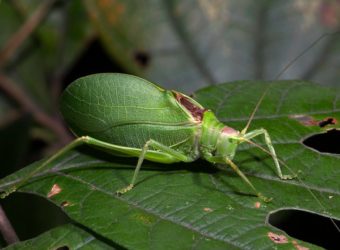It’s Noisy Out There!
When I was a child in Brooklyn, my own tiny yard was my wilderness, my jungle. During the warmer months I’d spend hours exploring every inch, until I felt like I knew each bee visiting our roses, millipede and beetle larva hiding under our flagstones, and praying mantis stalking the lilacs. My love of nature—and specifically of insects and other arthropods—began then and there, and it has never faded.
But everything was different after dark. Nighttime transformed familiar terrain into terra incognita, filled with odd rustlings, shadowy movements, and spookily unidentifiable sounds. Sounds, sometimes loud enough to drown out all others, that came from unseen creatures lurking in the dark trees and bushes.
I knew that the most dominant of those sounds—the endlessly repeated one that sounded like “Katydid!”—was, in fact, made by insects called katydids. But there were others, among them one I found especially eerie: a gradually accelerating cascade of clicks that would grow louder and louder before suddenly cutting to silence.
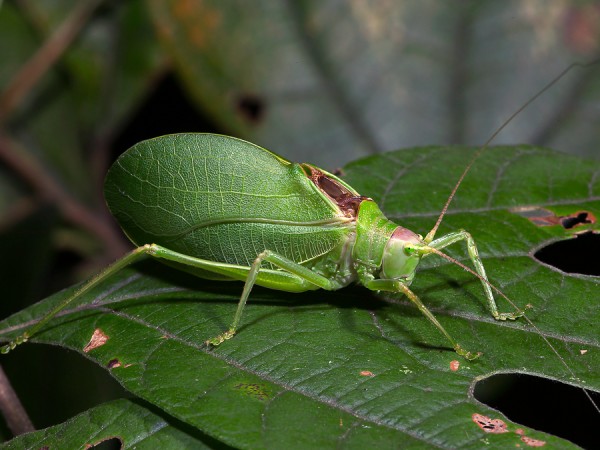
I’ve lived in Westchester for many years now, but late every summer, when the katydids and other members of this invisible chorus start calling in full force, I still feel a breath of the disquiet I felt as a child. (A childlike mournfulness, too: If birdsong is the sound of early summer and the zithering of cicadas the chorus of midsummer, then part of katydids’ message is: “Fall—and school—are coming.”)
But it wasn’t until the past few weeks, as I walked down the nighttime streets of my Croton neighborhood, listening to the cacophony, that I realized: The creatures that make these calls were still terra incognita—or whatever the insect equivalent is—to me. But they didn’t have to be.
Just a little bit of research revealed a few essential facts. Katydids, along with crickets, grasshoppers, and locusts, belong to the large insect order known as Orthoptera, which contains at least 20,000 species and can be found on every continent except Antarctica.
Most orthopterans eat plants and seeds (though crickets especially can be omnivorous), and many species are considered crop pests. Some—most famously the periodic “locust” swarming phase of certain grasshopper species—have caused such destruction of crops that their reputation as plagues has echoed throughout recorded history.
Katydids and their close relatives have no locust phase, and aren’t considered pests. Perhaps their most spectacular feature is that they are so hard to see, thanks to a remarkable combination of cryptic coloration and mimicry.
Many creatures seeking to avoid being a tasty meal for predators (and/or wanting to sneak up on a meal of their own) have evolved cryptic coloration, the ability to blend into their habitat. Thus nearly all katydids, which spend most of their time amid the leaves of bushes or trees, are bright green in color.
But it’s in the art of mimicry that katydids stand apart. If you’ve seen our most common—and noisiest—species, the Common True Katydid, you’ll get a good sense of what the group is up to. They’re not only leaf-green and leaf-shaped, but they even boast leaf details: patterns mimicking leaves’ veins and ribs that run through their folded wings. Even the female’s sharp ovipositor resembles the brownish tip of a leaf or stem. (Check out some amazing examples here: https://thesmallermajority.com/2012/09/06/leaf-eating-leaves/.)
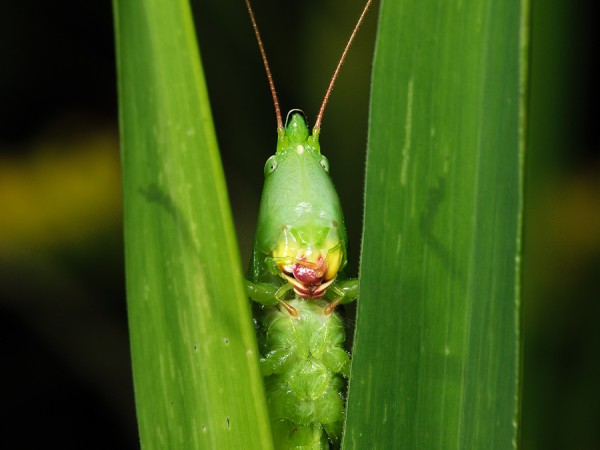
http://songsofinsects.com/katydids/sword-bearing-conehead
Other local katydid species, bearing such colorful names as the Rattler Round-winged Katydid and Sword-bearing Conehead (named not only for the head shape but for the female’s impressively long ovipositor) differ in size, shape, and hue, but all are variations on the basic green leaf.
That’s not true everywhere, though. As so often, it’s in the tropics that the orthopterans’ mimicry reaches its full—and astonishing—glory. Here lives the katydid subfamily Pterochrozinae, the “leaf-mimic” Katydids.
Unlike our local species, the leaf-mimics go far beyond resembling fresh green leaves. Some, inhabitants of leaf litter, look exactly like decaying brown leaves, often curled and spotted with “mold.” Other species are half green, half brown, like a leaf that is gradually dying. Still others seem to have “bites” taken out of them, as if they’ve recently been visited by a hungry caterpillar.
Everywhere, katydids’ ability to blend in to their surroundings means they are far more often heard then seen. Though we may occasionally come across one (usually a Common True Katydid) in plain view in street- or porch light, or even resting on a branch during the day, the main sign of katydids in the neighborhood is almost always the nighttime chorus.
Katydids “sing” by rubbing their legs together or against structures on the wings that have evolved for that purpose. Usually males alone call, seeking to stake out territory, assert dominance, and—most importantly—attract females.
Many species’ “ears” (actually a shallow pit covered by a tympanum, a membrane that serves as an eardrum) are located on the insect’s first pair of legs. If you find a katydid, look for oval brown patches near the crook of the forelegs. The placement of a katydid’s “ears” and the structure of its tympanum have evolved to vibrate at the frequency of the species’ calls and help locate the one that is calling.
In the Northeast, the katydid chorus is nearly always dominated by the Common True Katydid, which congregates in trees and high bushes. On warm nights they make so much noise, and so persistently, that it’s easy to miss that other species are calling, too.
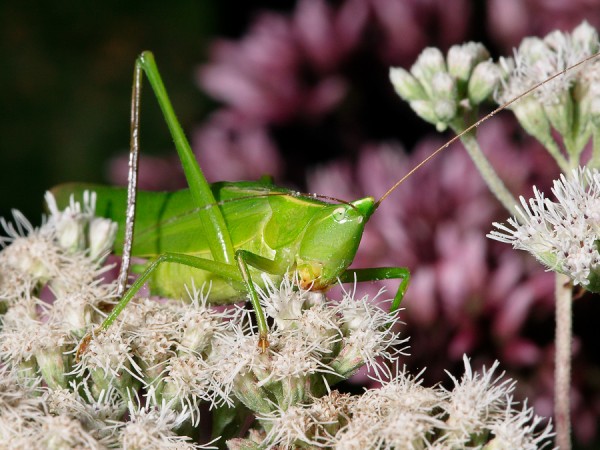
But they are. For example, the Robust Conehead—more likely to be found in fields with scattered trees—lets loose with an extraordinarily loud, harsh buzz that can continue for many seconds on end. Meanwhile, the Treetop Bush Katydid emits a simple, dry “Tzit!” or “Sip!” from its arboreal hiding places, a quieter call that is easily missed.
And what about the one I used to call the “click insect,” whose haunting, sporadic calls spooked me back in Brooklyn? It’s here in Croton, too: the Greater Anglewing, an especially large and beautiful species.
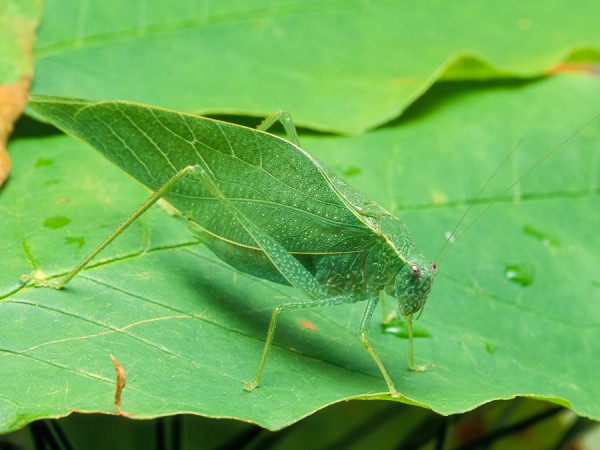
Sounds can carry us back in time, and writing this essay helped me recapture a long-lost memory. As a child, I used to watch a lot of cheesy monster movies on TV, and somewhere near the end a character would almost always peer into the darkness and say, “It’s quiet out there…too quiet.” (Then, invariably, something terrifying—and not quiet at all—would happen.)
I remember going out for a walk one night after watching one of those monster movies. Even as, heart pounding, I looked over my shoulder for some approaching bug-eyed alien, I thought, “Well, at least it’s not quiet out here. It’s noisy!”
Even now, decades later, I’m thrilled to see that nothing has changed. It’s noisy out there…just noisy enough.
Copyright © 2020 by Joseph Wallace
